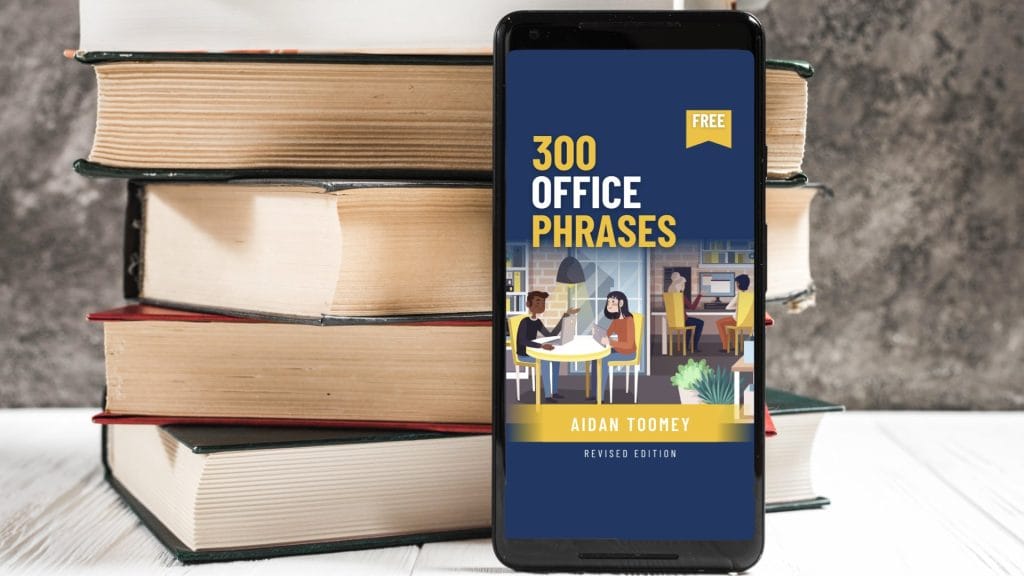
When delivering business presentations in English, your ability to effectively describe visual data can significantly impact how well your audience understands your message. Whether you’re presenting quarterly results, market trends, or project metrics, having the right phrases to describe charts, graphs, and other visuals is essential for business professionals.
This lesson provides you with professional English phrases for confidently describing various types of visual elements in your next business presentation, along with our free tutorial video demonstrating these techniques in action.
Please like and follow us on YouTube, and LinkedIn. And don’t forget –
FREE Resources to Support Your Learning
Grab our Ultimate 300 Business English Phrases for Communication in the Office ebook further below. Visit our FREE Business English lessons page.
Video Tutorial: Mastering Visual Descriptions in Presentations
Our video tutorial demonstrates how to use professional English phrases when describing charts, graphs, and other visual elements in business presentations. Watch as we walk through real examples and provide pronunciation tips for non-native English speakers.
When you’re describing visuals, give your audience enough time to absorb the information on the slide. Pause to allow your audience to look at the information and explain why the visual is important.
Essential Phrases to Help Describe Visuals
Introducing Visuals
- “The issues are illustrated in the next graph…”Example: “The issues with our current supply chain are illustrated in the next graph, which shows delivery delays across our three main distribution centers.”
- “Now, let’s take a look at/ Let’s take a look at/I’d like you to look at…”Example: “Now, let’s take a look at the customer satisfaction ratings for Q1 and Q2, which show a positive trend following our service improvements.”
- “You can see the results in this table.”Example: “You can see the results in this table, which breaks down sales performance by region and product category.”
- “I have a slide here that shows…”Example: “I have a slide here that shows the correlation between our marketing spend and website traffic over the past 12 months.”
- “According to the pie chart, growth is slow.”Example: “According to the pie chart, growth is slow in the European market, accounting for only 7% of our total expansion this year.”
- “As you can see here…”Example: “As you can see here, customer acquisition costs decreased by 15% after implementing the new digital strategy.”
- “The chart on the following slide shows…”Example: “The chart on the following slide shows year-on-year comparisons for our top five product lines, with the blue bars representing this year’s figures.”
Pro Tip: When you show a visual, start with a phrase that tells your audience to look at it. This helps everyone focus on the visual and makes your presentation smoother.
Explaining Visuals
- “First, let me quickly explain this flow chart.”Example: “First, let me quickly explain this flow chart. It represents our new approval process, with each color indicating a different department’s responsibilities.”
- “The key is in the top right hand corner.”Example: “The key is in the top right hand corner, showing that blue represents domestic sales while red represents international markets.”
- “The different colours are used to indicate.”Example: “The different colours are used to indicate customer segments: green for new customers, yellow for returning customers, and purple for premium subscribers.”
- “You can see here, the sales data for the past year.”Example: “You can see here, the sales data for the past year, with each column representing a different quarter and showing the seasonal nature of our business.”
- “The new dates are listed across the bottom.”Example: “The new dates are listed across the bottom, covering our planned product launches from May through December of this year.”
- “From Table 2, we can see/conclude/show/estimate/calculate that…”Example: “From Table 2, we can conclude that our investment in customer service training has resulted in a 24% decrease in complaint rates across all departments.”
Pro Tip: When explaining complex visuals, start with the overall structure before diving into specific data points. This creates a mental framework that helps your audience understand how individual pieces of information fit into the bigger picture.
Highlighting Information
- “I’d like to stress/highlight/emphasise the following points.”Example: “I’d like to emphasize the following points from this market research data: first, that 68% of respondents preferred our new packaging, and second, that willingness to pay increased by 12%.
- ““I’d like you to think about the significance of the figure here.”Example: “I’d like you to think about the significance of the figure here showing a 40% reduction in carbon emissions, which puts us three years ahead of our sustainability targets.”
- “I’d like to point out one or two interesting details.”Example: “I’d like to point out one or two interesting details in this customer journey map, particularly the high drop-off rate at the payment confirmation stage.”
- “I’d also like to draw your attention to the top half of the graph.”Example: “I’d also like to draw your attention to the top half of the graph, which shows how our market share has grown consistently in the 18-34 demographic.”
- “Let’s look more closely at…”Example: “Let’s look more closely at the fourth quarter results, which exceeded projections by 12% despite the challenging economic conditions.”
- “What I’d like to point out here is…”Example: “What I’d like to point out here is the strong correlation between employee training hours and productivity improvements across all departments.”
Pro Tip: When highlighting specific information, use your voice, gestures, and visual aids (like laser pointers or on-screen highlights) together to create multiple reinforcing signals that help your audience focus on the exact data point you’re discussing.
Types of Visual Data in Business Presentations
In business presentations, you’ll encounter various types of visual data that require different descriptive approaches:
- Bar charts – Compare quantities across different categories
- Line graphs – Show trends and changes over time
- Pie charts – Display proportions of a whole
- Tables – Present detailed numerical data in rows and columns
- Flowcharts – Illustrate processes or decision paths
- Scatter plots – Show relationships between variables
- Infographics – Combine data visualizations with explanatory text.
Tips for Effectively Describing Visual Data
- Start with context – Explain what the visual represents before diving into details.
- Be specific – Use precise figures and percentages when highlighting important data.
- Guide your audience – Direct attention to the most significant elements.
- Connect to business impact – Explain what the data means for your business objectives.
- Use transitions – Move smoothly between different visuals or sections.
- Practice pronunciation – Ensure you can confidently say numbers and statistical terms.
Real-World Example: Describing a Sales Performance Graph
Let me walk you through this line graph showing our sales performance over the past 12 months. The horizontal axis represents time in months, while the vertical axis shows sales figures in thousands of dollars.
As you can see here, we started the year at approximately $45,000 in January. Now, let’s take a look at the significant increase in sales in April when we launched our new product line. You can see the peak in June at $78,000, coinciding with our summer promotion.
What I’d like to point out here is the decline in August, dropping to $52,000, which coincided with supply chain issues. The chart on this slide shows that sales have been on a steady upward trajectory since September.
Common Challenges When Describing Visuals in English
- Using appropriate terminology – Different charts and graphs have specific vocabulary.
- Transitioning smoothly – Moving naturally between describing and interpreting the data.
- Handling questions – Being prepared to explain details when asked.
- Managing time – Finding the right balance between detail and brevity.
- Maintaining audience engagement – Keeping your audience interested in statistical data.
Explore More Business English Resources
Looking for more Business English tips, courses, and free resources? Visit our LinkTree page to access everything in one place: https://linktr.ee/toomeybusinessenglish
Take Your Skills to the Next Level
If you’re looking to further improve your presentation skills, consider enrolling in our “Improve Your Business English: English for Presentations” course! Designed for non-native speakers, this course will help you master essential phrases and techniques to deliver impactful presentations with confidence.
Key Benefits:
- Learn over 200 essential phrases for every part of a presentation.
- Gain practical skills through interactive activities and quizzes.
- Enjoy lifetime access to course materials and updates.
- Receive a certificate of completion to showcase your skills.
Who Should Enroll?
This course is perfect for professionals, students, and anyone looking to enhance their presentation skills in English.
Enrol today and get the special discount at:- https://toomeybusinessenglish.com/presentations-business-english/
If You Liked This Article, Try These Next!
- Cut the Jargon in Presentations: Using Business English
- Learn how to simplify your language for clearer communication in presentations.
- Learn How to Do an Elevator Pitch Using Business English
- Master the art of delivering concise and impactful elevator pitches.
- Placement Phrases for Presentations Using Business English
- Discover essential phrases to effectively position your ideas during presentations.
- Using Formal and Informal Phrases to Start Your Presentation
Learn how to effectively engage your audience from the very beginning of your presentations.
FREE! THE ULTIMATE 300 BUSINESS ENGLISH PHRASES FOR COMMUNICATION IN THE OFFICE

